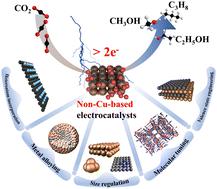当前位置:
X-MOL 学术
›
Energy Environ. Sci.
›
论文详情
Our official English website, www.x-mol.net, welcomes your
feedback! (Note: you will need to create a separate account there.)
Revolutionizing electrochemical CO2 reduction to deeply reduced products on non-Cu-based electrocatalysts
Energy & Environmental Science ( IF 32.4 ) Pub Date : 2024-06-19 , DOI: 10.1039/d4ee01301h Haoming Yu 1, 2 , Hsiwen Wu 1 , Yuen Leong Chow 1, 3 , Jun Wang 2 , Jie Zhang 1, 4, 5
Energy & Environmental Science ( IF 32.4 ) Pub Date : 2024-06-19 , DOI: 10.1039/d4ee01301h Haoming Yu 1, 2 , Hsiwen Wu 1 , Yuen Leong Chow 1, 3 , Jun Wang 2 , Jie Zhang 1, 4, 5
Affiliation

|
Producing deeply reduced (net number of electrons transferred per carbon atom greater than two, > 2e−) products from electrochemical CO2 reduction reaction (eCO2RR) is an attractive and sustainable approach for CO2 utilization. Current research on deeply reduced products in eCO2RR focuses on copper (Cu)-based electrocatalysts, and significant advances in improving the activity and selectivity have been achieved in the past decade. However, the intrinsically low selectivity (broad product profile) and poor stability still constitute the bottleneck of Cu-based eCO2RR technology. Non-Cu-based electrocatalysts are promising alternatives to convert CO2 into deeply reduced products. Nonetheless, current understanding of such a process on non-Cu surfaces is relatively limited, and a comprehensive review in this direction is still lacking. This review summarizes recent research progress in non-Cu-based electrocatalysts capable of producing deeply reduced products at an appreciable rate and selectivity, and outlines considerations in the screening of non-Cu-based electrocatalysts. Firstly, the fundamentals of eCO2RR are introduced, with particular focus on reaction pathways and selectivity-determining intermediates found exclusively on non-Cu surfaces. We highlight C–C coupling pathways unique to non-Cu surfaces, and also the trend that the greater the number of electrons transferred prior to the C–C coupling step, the higher the single selectivity of the deeply reduced product. Next, recently reported design strategies on non-Cu-based electrocatalysts are summarized, followed by a survey on novel catalyst screening via combined density functional theory calculations and machine learning, with prospective potent catalysts highlighted. Finally, key considerations and research directions are proposed for developing advanced non-Cu-based electrocatalysts. This review aims to provide comprehensive insights into designing high-performance non-Cu-based eCO2RR catalysts and to stimulate more research endeavors in this increasingly important direction.
中文翻译:

彻底改变电化学二氧化碳还原,在非铜基电催化剂上深度还原产物
通过电化学 CO 2 还原反应 (eCO 2 RR) 产生深度还原的产物(每个碳原子转移的电子净数大于 2,> 2e − )是一种有吸引力且可持续的二氧化碳 2 利用方法。目前eCO 2 RR中深度还原产物的研究主要集中在铜(Cu)基电催化剂上,并且在过去十年中在提高活性和选择性方面取得了重大进展。然而,本质上较低的选择性(广泛的产品谱)和较差的稳定性仍然构成铜基eCO 2 RR技术的瓶颈。非铜基电催化剂是将 CO 2 转化为深度还原产品的有前途的替代品。尽管如此,目前对非铜表面上这种过程的理解相对有限,并且仍然缺乏这个方向的全面综述。本文总结了非铜基电催化剂的最新研究进展,该催化剂能够以可观的速率和选择性生产深度还原产物,并概述了非铜基电催化剂筛选的注意事项。首先,介绍了 eCO 2 RR 的基本原理,特别关注仅在非铜表面上发现的反应途径和选择性决定中间体。我们重点介绍了非铜表面特有的 C-C 偶联途径,以及在 C-C 偶联步骤之前转移的电子数量越多,深度还原产物的单一选择性越高的趋势。 接下来,总结了最近报道的非铜基电催化剂的设计策略,然后通过结合密度泛函理论计算和机器学习对新型催化剂筛选进行了调查,并重点介绍了潜在的有效催化剂。最后,提出了开发先进非铜基电催化剂的关键考虑因素和研究方向。本综述旨在为设计高性能非铜基 eCO 2 RR 催化剂提供全面的见解,并激发在这个日益重要的方向上进行更多的研究工作。
更新日期:2024-06-19
中文翻译:

彻底改变电化学二氧化碳还原,在非铜基电催化剂上深度还原产物
通过电化学 CO 2 还原反应 (eCO 2 RR) 产生深度还原的产物(每个碳原子转移的电子净数大于 2,> 2e − )是一种有吸引力且可持续的二氧化碳 2 利用方法。目前eCO 2 RR中深度还原产物的研究主要集中在铜(Cu)基电催化剂上,并且在过去十年中在提高活性和选择性方面取得了重大进展。然而,本质上较低的选择性(广泛的产品谱)和较差的稳定性仍然构成铜基eCO 2 RR技术的瓶颈。非铜基电催化剂是将 CO 2 转化为深度还原产品的有前途的替代品。尽管如此,目前对非铜表面上这种过程的理解相对有限,并且仍然缺乏这个方向的全面综述。本文总结了非铜基电催化剂的最新研究进展,该催化剂能够以可观的速率和选择性生产深度还原产物,并概述了非铜基电催化剂筛选的注意事项。首先,介绍了 eCO 2 RR 的基本原理,特别关注仅在非铜表面上发现的反应途径和选择性决定中间体。我们重点介绍了非铜表面特有的 C-C 偶联途径,以及在 C-C 偶联步骤之前转移的电子数量越多,深度还原产物的单一选择性越高的趋势。 接下来,总结了最近报道的非铜基电催化剂的设计策略,然后通过结合密度泛函理论计算和机器学习对新型催化剂筛选进行了调查,并重点介绍了潜在的有效催化剂。最后,提出了开发先进非铜基电催化剂的关键考虑因素和研究方向。本综述旨在为设计高性能非铜基 eCO 2 RR 催化剂提供全面的见解,并激发在这个日益重要的方向上进行更多的研究工作。











































 京公网安备 11010802027423号
京公网安备 11010802027423号